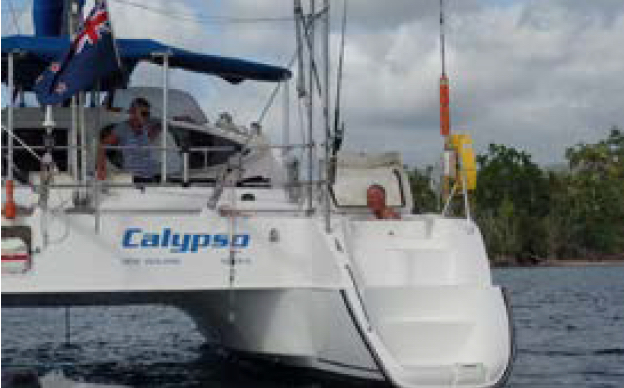
What Works…
Beware the Cascade Effect!
Looking a little like a Gopher with his head out of the engine compartment Mike found out firsthand what I mean by the “Cascade Effect”.
The Cascade effect could easily be linked to any number of Murphy’s Rules, for example, “If anything can go wrong it will.”
A quick visual inspection in the lead up to an ocean passage from Fiji to Vanuatu Mike noticed some black “Gunk” in the water trap for the starboard engine fuel supply. Expert opinion from some well informed sources agreed the “Gunk” was in fact diesel bug so a regime was developed to rid Calypso of this not uncommon problem.
The tank was drained, it was less than a quarter full, filtered and then the now clean diesel put back in the tank, wonderful. Now, as the glass water trap had been emptied and cleaned to get rid of the gunk it was necessary to refill it with fuel. Constant and rapid use of the lift pump just wouldn’t get the job done.
The experts after a quick inspection noted that the Manufacturer had mounted the water trap, for easy inspection, on the forward engine compartment bulkhead, at a level well above the level of diesel now in the tank. Perhaps they presumed one would only clean the water trap by draining it from the bottom of the glass while the tank was full. The problem though was, not only in this case was the tank not full but the sight glass had been removed for a thorough cleaning. Once reinstalled and nicely clean not only was the glass bowl empty but the fuel in the lines had drained back into the tank.
The solution in this case was to borrow some diesel from another boat, yes you guessed it from the ever present plastic Gerry cans you seem to see on most cruising boats. We do sail occasionally, Honest! Top the tank up to close to the level of the Water trap and try again with the lift pump. Fortunately this worked and all was now well.
There are a couple of easy fixes with this type of fuel system. Firstly, a fuel shut off cock between the Filter / Water trap and perhaps the addition of a squeeze type hand pump, as you always see in an outboard motor fuel line, to assist with lifting the fuel (make sure you get the right grade of material, diesel will eat some rubbers).
Looking towards the future, both tanks will need to be properly cleaned to remove any bug residue. I’d also look at adding a separate large Racor type filter to compliment the Water trap in this system or replace the water trap with a combination unit. In the way it’s currently set up the fuel is only filtered by the standard small fuel filter mounted on the engine, great for harbour or short coastal use but not for long distance cruising.
